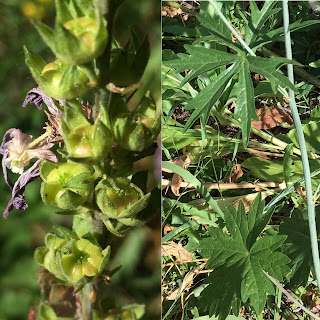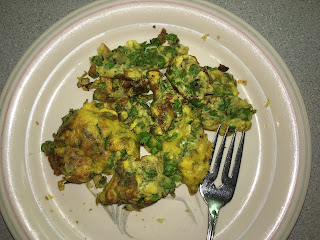 |
| Asclepias speciosa |
Showy Milkweed (
Asclepias speciosa) is fairly common along roadsides and in fields. It is easily recognized by the large leaves with milky juice, and the balls of alien-looking flowers. Most people appreciate it for the butterflies it attracts. But it is also a good edible plant, but different parts are edible at different times of the year, so it may take some time and experience to learn to use it effectively. My experiences below were collected over several years.
I had a milkweed plant volunteer to grow in my yard a couple years ago. Each year I have a few more. As a result, I have had the opportunity to try out the various parts as the plants mature.
They seem to propagate by rhizomes better than they do by seeds. They produce a lot of flowers, but few seed pods.
Sam Thayer gives an excellent and detailed description of Milkweed in his book, The Forager's Harvest. Technically, he is working with
Asclepias syriaca, a different species, but it is very similar.
A. syriaca is considered the eastern variety, and
A. speciosa is the western variety.
A. speciosa has larger, showier flowers, but they both have the large, wide leaves which are not found in other milkweeds. My experiences agree with Sam Thayer's report in all other respects.
 |
| Shoots, ready for cooking |
Shoots
In the spring, the shoots are the first vegetable this plant gives us. As with all immature plants, accurate identification at this stage can be difficult. If you know where the plants were growing the previous year, they will also be growing there the next year, so that will reduce a lot of the guesswork. I found the shoots fairly disappointing. They were rather mushy and bland after boiling and peeling, as Sam Thayer recommended, and there was not much left after peeling. It is quite likely that the shoots I picked were already a bit too old for best eating, so I will be experimenting more with it in the future.
One problem turns out to be overcooking. Most sources recommend 20 minutes, but in my experience that is much too long. Even 10 minutes left them on the mushy side. In my tests, about 7 minutes was about right to make it tender, but still leave enough texture to enhance the experience. At that point, I would call it merely mild-flavored, rather than bland. I cannot detect any bitterness at all. These are still not as good asparagus, but few things are.
The bottom of the shoot is tougher than the top. When young enough for good picking, shoots will typically have several pairs of leaves at the top, and then a space of several inches before the next pair of leaves, which are often smaller. The shoot seems to start toughening up right around that set of leaves, so that would be a good point to break off the stem in order to get the tenderest parts. There will always be a copious amount of milky sap leaking from the broken stem. You can shake some of this off, but it dries to near-invisibility after a few minutes.
 |
| immature flower buds |
Buds
I gathered some of the unopened flower buds when they were still quite small (1/4" or less). A quick wash in cold water removed any of the milky sap from where they broke from the stem. I tried them boiled or steamed for 5 minutes. I thought the boiled ones were better. They were mild with a hint of sweetness, cooked enough but not yet mushy from overcooking. The taste is similar to the shoots, but with more texture instead of being mushy. I enjoyed the flavor and texture a lot, and would definitely recommend trying it. The steamed ones were similar but were a bit firmer, probably because they had not gotten cooked as much. They also had a slightly bitter taste along with the sweetness, which the water must have helped remove from the boiled ones.
Since they are buds, it is tempting to compare them to broccoli. Broccoli is a much tougher vegetable with even smaller buds. It stands up to a lot more cooking, while still retaining much firmness. Milkweeds buds are tender, so one should be careful not to over cook them. Boiling helps remove any bitterness. And the result is not much like broccoli; it is a milder and more tender flavor.
You have to find these at the right stage of growth. One might feel a twinge of guilt by prevented the plant from producing its flowers, but the plants are perennial and regrow from the same roots each year. Also, considering how many flowers are produced compared to how few actually mature into pods, this might be the most abundant part available for eating.
Flowers
I tried a few of the flowers raw. The milkweed flower is an alien-looking thing, with an extra structure between the petals and stamens, referred to as the corona. It is an appropriate name, since it is crown-like in this species, with little spikes bending over into the center of the flower. It is the most prominent part of the flower, and it is fleshy and not bad tasting raw. Several authors have mentioned the possibility of boiling the flowers down to make a syrup, but I have not found a first person account of this yet.
Pods
The pods were the part I was most interested in trying this year. They are tenderest when about an inch to an inch-and-a-half long, but are still good to three inches. If the outside has started to get a more spiky appearance and the seeds on the inside have started to spread out, then it is going to be tough. But if the outside is merely bumpy and the seeds inside are packed tightly together, it is probably still tender enough to eat.
I boiled the pods for five to ten minutes, and found that they were mild tasting and had a good texture. There are hollow spaces inside the pod next to the seeds and between the inner and outer layers of the rind, so the texture is more like eating a pepper than a more solid fruit. The green outer part of the pod is mild tasting (not bitter at all), and the white insides are slightly sweet.
Silk
The pod has an indented seam along one side, which can easily be pulled apart to get at the insides, the seeds and silk and central supporting structure. Sam Thayer recommends using the insides from larger but still immature pods (up to three inches) to boil and mix into a mild cheesy product. At this stage, the silk should be soft and easily pulled apart, not silky or fibrous at all. I did not have enough this year to get a large amount, but the insides from a couple pods produced a pleasantly sweet mix of mushy silk and tender seeds. (Mature silk also works great as a flash tinder: it catches fire very easily but does not burn for long.)
The pods from which the silk and seeds have been removed can also be eaten, but they should not be broken before cooking. The tender ones will become mushy and the less tender ones will not get any more tender.















